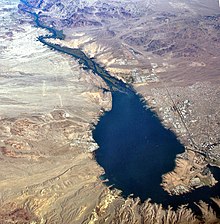Lake Havasu
| Lake Havasu | ||
|---|---|---|
Primary inflows Colorado River | | |
| Primary outflows | Colorado River | |
| Basin countries | United States | |
| Max. length | 26.3 miles (42.3 km) | |
| Max. width | 2.85 miles (4.59 km) | |
| Surface area | 19,300 acres (7,800 ha) | |
| Average depth | 35 ft (11 m) | |
| Max. depth | 90 ft (27 m) | |
| Surface elevation | 448 ft (137 m) | |
| Islands | 1 | |
| Settlements | Lake Havasu City, Arizona | |
Lake Havasu (
Aqueducts
Mark Wilmer Pumping Plant pumps water into the
Natural history

The shorelines are in the ecotone (transition zone) of the higher Mojave Desert to the lower Sonoran Desert and its Californian Colorado Desert ecoregions.[citation needed]
The Havasu National Wildlife Refuge is located at the upper end and upriver. Lake Havasu State Park is along the eastern shore in Arizona. The Bill Williams River National Wildlife Refuge extends southeastward up the riparian zone of the Bill Williams River canyon from the southeastern end of the reservoir and dam.[citation needed]
Fish
Lake Havasu is well known for its recreational fishing and boating, which bring in about a million visitors a year.[2] Fishing tournaments are often held on the lake, where bass are the main catch.[citation needed]
Fish list :
White sturgeon were stocked in Lake Havasu in 1967 and 1968 from stock obtained from San Pablo Bay, California. While some dead sturgeon were found downstream from Havasu (probably killed during passage over dams), living fish have not been recorded, but may still exist along the southern end of Lake Havasu near Parker Dam.[3] Sturgeon have been known to grow upwards of 20 feet (6.1 meters) and can live in excess of 100 years and many in and around Lake Havasu continue in their efforts to catch a glimpse of the majestic animal.[citation needed]
The California Office of Environmental Health Hazard Assessment (OEHHA) has developed a safe eating advisory for Lake Havasu based on levels of mercury found in fish caught from this water body.[4]
See also
- Lake Havasu City, Arizona
- Robert P. McCulloch
- London Bridge (Lake Havasu City)
- List of dams and reservoirs in California
- List of lakes in California
- List of largest reservoirs of California
- Windsor Beach, Lake Havasu
Image gallery
-
Early-morning fishing on Lake Havasu
-
London Bridge at Lake Havasu.
-
View from London Bridge
References
- ISBN 0-520-01432-4.
- ^ "About Lake Havasu City". golakehavasu.com. Lake Havasu City Convention & Visitors Bureau. Retrieved September 3, 2023.
- ^ "Acipenser transmontanus". Retrieved 2008-01-05.
- ^ Pham, Huyen Tran (2017-01-24). "Lake Havasu". OEHHA. Retrieved 2018-06-13.
External links
- United States Bureau of Reclamation
- Lake Havasu News Archived 2016-02-22 at the Wayback Machine
- "Metropolitan Water Department of Southern California" (PDF). Archived from the original (PDF) on 2006-07-24. (212 KiB)
- Arizona Boating Locations Facilities Map
- USGS – Real-time water data for Lake Havasu near Parker Dam
- Daily data of level and flow from US Department of the Interior | Bureau of Reclamation | Lower Colorado Region
- Lake Havasu Colorado River Interactive Map







